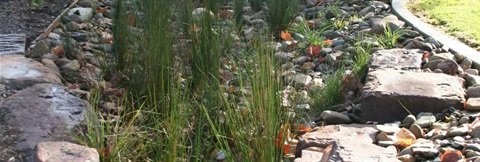Indigenous Gardens
Published on 01 August 2022

Indigenous plants are plants that are local to a region and superbly adapted to local climate and soil conditions. This makes them a logical choice for low-maintenance, sustainable gardens. They also make the ideal habitat for local wildlife.
Sustainable
An indigenous garden, once established
- will require minimal maintenance and watering,
- can be designed to take on a variety of styles, such as bush garden, rain garden, cottage garden, or even formal garden while still being low maintenance (see examples in design section),
- can complement existing ornamental gardens and thus reduce the overall maintenance and watering requirements of the garden,
- can create micro-climate zones in the garden.
Well designed micro-climate zones in a garden can be cooler than their surrounds. This is achieved by establishing canopy plants for shade, suitable undergrowth, water features for evaporative cooling effect and the use of non-reflective, permeable materials for paths and sitting areas.
Biodiverse
Many of Maroondah’s bushland reserves are relatively small pockets of remnant vegetation, but do support diverse ecosystems and contain plants that are locally rare and significant. Often they depend on human intervention for their survival.
The Maroondah Bushland team, with significant support from many volunteers, maintains these reserves by removing weed infestations and regenerating or revegetating depleted areas.
Indigenous gardens designed with this in mind:
- strengthen existing corridors and increase the number of habitat pockets within Maroondah
- can create new corridors that link to remnant flora and fauna ecosystems in Maroondah’s bushland reserves
- protect fragile local natural areas by reducing potential weed infestations caused by weedy plants escaping from gardens
- create new habitats for wildlife, • significantly reduce ongoing maintenance, fertiliser and water use
- create inviting outdoor living areas
- raise awareness and appreciation of local indigenous vegetation and wildlife.
Kilsyth South Spider Orchid
Maroondah is home to a number of rare and locally or regionally significant species, and with only 5% cover of remnant indigenous vegetation cover remaining, those species are under tremendous pressure from weed infestation and vandalism. Where possible, revegetation is undertaken, however, many orchid species for example cannot be propagated. Careful management of sensitive areas is therefore essential.
One example of a precious and rare plant is the Kilsyth South Spider Orchid —Caladenia sp. Kilsyth South (G.S.Lorimer 1253) Vic. Herbarium. It only occurs in a reserve in Maroondah and nowhere else in the world. Weed infestation significantly impacts on its habitat and, as it cannot be propagated, it could be lost forever.
See the publication Indigenous Gardens - Creating habitat for people and wildlife in Maroondah(PDF, 4MB) for more information on getting started and garden design.